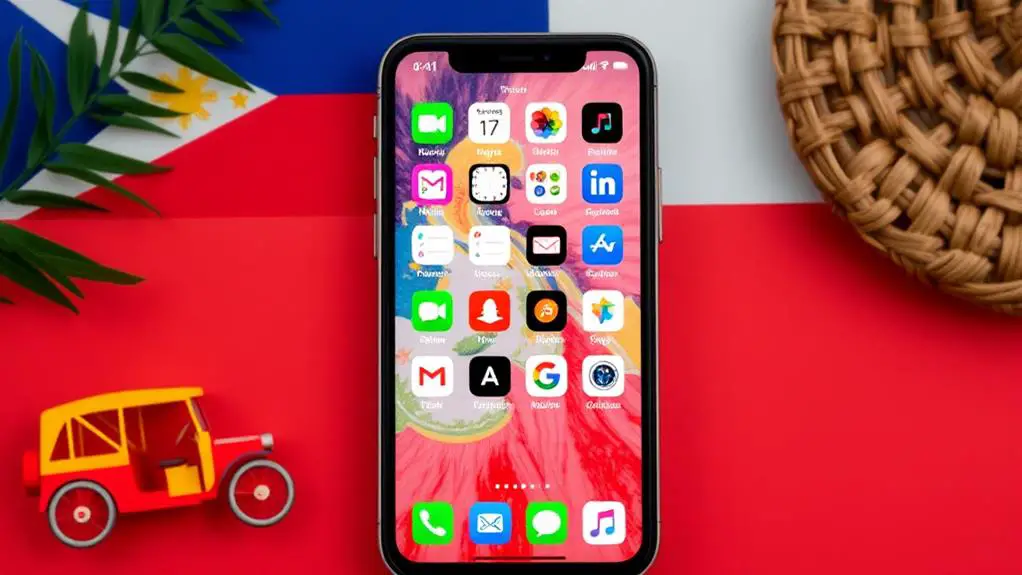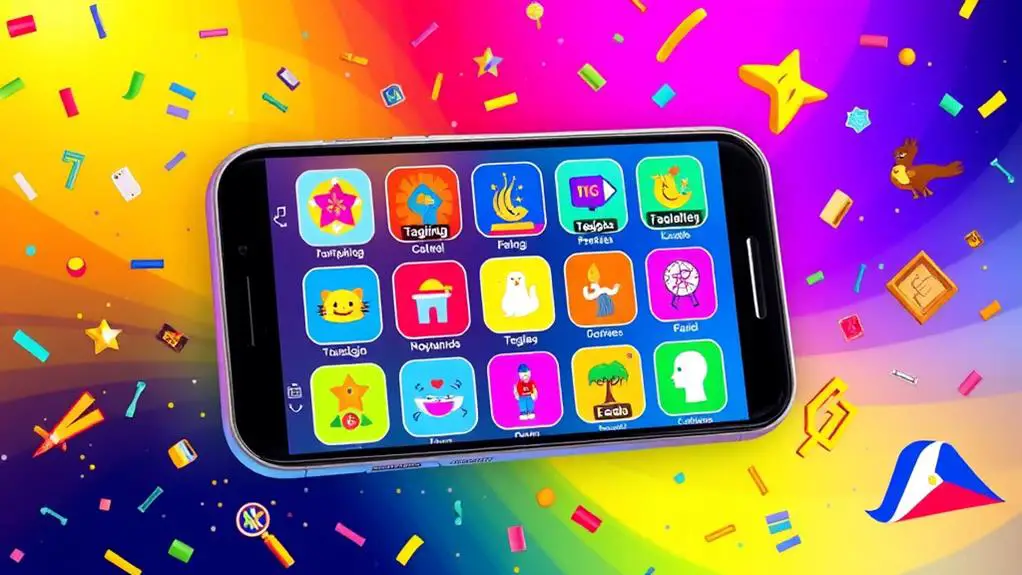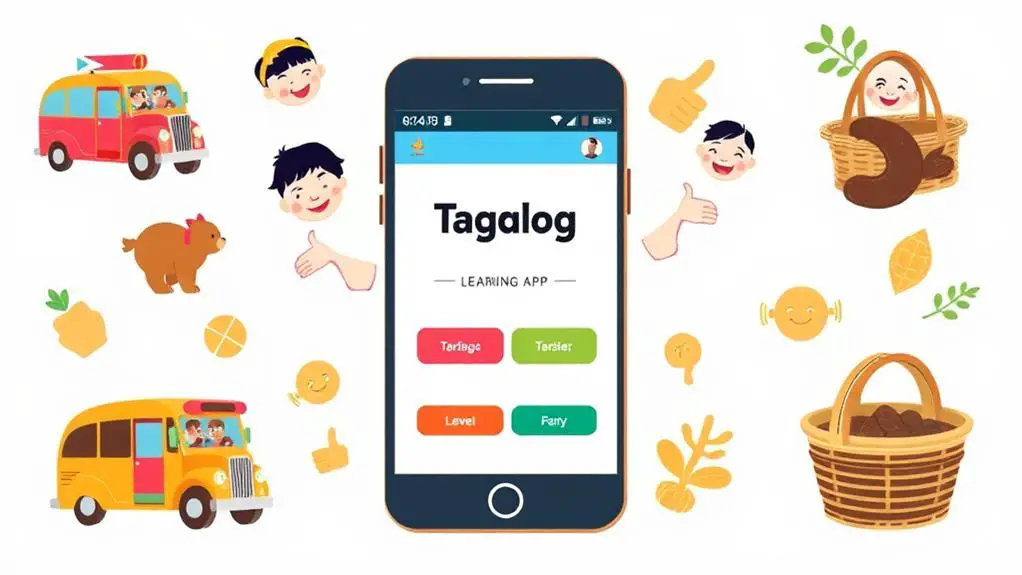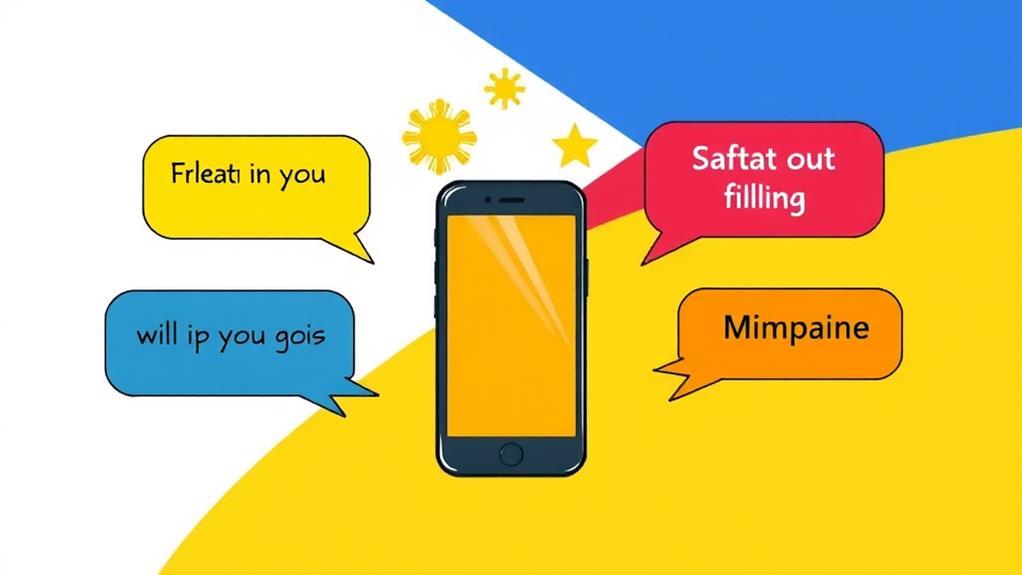Structured Learning for Comprehensive Progress
For beginner learners, FilipinoPod101, Pimsleur, Mango Languages, Ling, and Italki offer structured lessons, audio materials, and personalized tutoring to accelerate language acquisition. These apps provide a comprehensive learning experience, covering various aspects of the Tagalog language.
Engaging and Fun Learning
Drops and Ling are gamified apps that make learning Tagalog an enjoyable experience. These apps incorporate interactive elements, such as games and quizzes, to keep learners motivated and engaged.
Tracking Progress and Assessments
Clear Plan and Mango Languages provide assessments and measurable progression, allowing learners to track their progress and identify areas for improvement. This feature helps learners stay focused and motivated throughout their language learning journey.
By exploring these top Tagalog language learning apps, learners can find the perfect combination to enhance their learning experience and achieve fluency in Tagalog.
Top Apps for Beginner Learners

Comprehensive Library of Lessons
FilipinoPod101 offers a vast library of video and podcast lessons tailored for beginners. These lessons allow you to customize your learning pathway with a focus on practical vocabulary and cultural insights.
Audio-Based Approach
Pimsleur's 100% audio lessons can quickly develop your conversational skills. This approach is ideal for those who prefer to learn through listening.
Building Vocabulary
Drops is a great option for building vocabulary. You'll learn through visual association and gamified activities, making it an engaging and effective way to build a foundational word bank in Tagalog.
Structured Approach
Mango Languages offers a guided curriculum with clear learning goals. This approach is ideal for those who prefer a structured learning path.
Structured Language Learning
A clear plan is essential for achieving Tagalog fluency. Structured language learning provides a clear progression through foundational skills, enabling efficient mastery of vocabulary and grammar. For instance, apps like Mango Languages and Pimsleur offer structured curriculums that focus on specific learning goals, enhancing retention and comprehension over time.
FilipinoPod101 takes it a step further with customizable learning pathways, allowing you to select topics of interest while maintaining a structured approach to language acquisition.
Assessments and progress tracking are vital for staying motivated and measuring growth systematically. These language learning platforms often provide such features, which help you stay on track and see the progress you've made.
By utilizing structured lessons from these apps, you can significantly reduce the time needed to achieve conversational proficiency. With dedicated practice, you can yield noticeable results in a few months.
Following a structured approach enables you to efficiently build your skills and achieve your learning goals. With Tagalog lessons tailored to your needs, you'll be speaking like a native in no time.
Gamified Learning Experiences

Gamified Learning Apps Enhance Engagement and Retention
Gamified learning apps, such as Drops and Ling, are an effective way to make Tagalog language acquisition more enjoyable and effective. These apps utilize engaging mini-games and challenges to reinforce vocabulary acquisition, making the learning process more fun and interactive.
For example, you can practice speaking with voice recognition to receive pronunciation feedback, and spaced repetition techniques help you retain over 1,000 Tagalog words and phrases through short, frequent sessions that fit easily into your daily routine.
Motivation and Progress Tracking
Gamified learning platforms also offer rewards, competitions, and level unlocking to motivate learners and foster a sense of accomplishment as they progress through lessons. Research shows that gamified learning experiences can significantly enhance engagement and retention rates compared to traditional study methods.
By incorporating gamified learning into your routine, you're more likely to stick with it and make progress.
Incorporating Gamified Learning into Your Routine
Gamified learning can enhance your Tagalog learning experience by making it more engaging and interactive.
Effective Learning Strategies
A well-structured approach to learning is essential for beginners in Tagalog. To maximize the effectiveness of language learning apps, incorporate consistent daily practice, even if it's just 5-minute sessions. This habit significantly enhances retention and reinforces learning.
Multimedia resources like podcasts and videos cater to individual learning styles and reinforce vocabulary through engaging content. For example, listening to a podcast about Filipino culture can help learners associate new vocabulary with real-life contexts.
Setting achievable and specific goals is crucial for maintaining motivation and providing a clear path for progress. For instance, learning a set number of words each week helps learners stay focused and track their progress.
Engaging with native speakers through language exchange platforms like Tandem facilitates real conversational practice essential for improving fluency and comprehension. This type of practice enables learners to apply their knowledge in real-life conversations.
Gamified apps like Drops and Memrise make vocabulary acquisition enjoyable and effective. These apps leverage spaced repetition to aid memory retention, ensuring that learners recall new vocabulary more efficiently.
By combining these effective learning strategies, learners can become proficient in Tagalog.
Understanding Tagalog Grammar

Mastering Tagalog Grammar
Verb Conjugations and Verbal Aspect
Tagalog grammar places a strong emphasis on verb conjugations and the verbal aspect, which determines the time and manner of actions. Verbs change form depending on the time and manner of the action, such as completed, ongoing, or intended actions. For example, the verb "kain" (to eat) becomes "kinain" (ate) in the past tense, "kumakain" (is eating) in the present tense, and "kakain" (will eat) in the future tense.
Pronouns and Focus
Tagalog employs an "actor-focus" and "object-focus" system, which alters verb forms to highlight either the doer of the action or the recipient of the action. The pronouns "ako" (I) and "siya" (he/she) change form depending on the focus, such as "ako" becoming "ko" in the object focus. For example, "Ako ang nagluto ng pagkain" (I cooked the food, actor focus) becomes "Kinluto ko ang pagkain" (I was the one who cooked the food, object focus).
Word Order and Grammatical Markers
Tagalog typically follows a Verb-Subject-Object (VSO) word order, although variations can occur depending on context and emphasis. Grammatical markers such as "ang," "ng," and "sa" indicate the roles of nouns in a sentence, similar to articles and prepositions in English. For example, "Ang lalaki ay kumakain ng mga prutas sa mesa" (The man is eating fruits on the table).
Best Apps for Comprehensive Learning
To effectively learn Tagalog, you need an app that offers a comprehensive approach. FilipinoPod101, Pimsleur, Mango Languages, Ling, and Italki are the top apps for comprehensive Tagalog learning.
FilipinoPod101 provides a customizable learning pathway with a wide range of video and podcast lessons, covering various topics. Additionally, you can get up to 77% off subscriptions with a coupon code.
Pimsleur develops conversational skills quickly through its 100% audio-based approach, featuring authentic dialogue and spaced repetition. The monthly subscription costs around $20.
Mango Languages offers structured lessons focusing on practical vocabulary and cultural insights at $7.99 per month, ideal for busy learners.
Ling combines gamification with language learning through mini-games and rewards, featuring over 50 languages, including Tagalog.
Italki connects you with qualified Tagalog tutors for personalized lessons via video chat, with prices starting as low as $5.00 per lesson.
These apps provide quality audio, flashcard decks, and online lessons, making them perfect for beginner learners seeking conversational Filipino and language exchanges.
User Experience and Community Support

A well-designed user experience is crucial to staying motivated and engaged in your language learning journey. Many language learning apps recognize this importance and offer features that promote community support and interaction.
For instance, apps like Tandem and HelloTalk connect you with native speakers for real-time conversation practice, fostering a sense of connection and cultural exchange. These community support features provide opportunities for language learners to practice speaking and listening skills in a more immersive and interactive way.
Apps that provide interactive forums and community discussions facilitate language learning. FilipinoPod101, for example, offers interactive forums and community discussions where learners can ask questions, share experiences, and receive feedback from fellow learners and instructors.
This type of community engagement helps learners stay motivated and engaged in their language learning journey.
Progress tracking features also play a crucial role in promoting community engagement. Apps like Ling and Drops provide features that allow learners to monitor their progress, encouraging community engagement through shared achievements and milestones.
By sharing progress and achievements, learners can stay motivated and inspired to continue improving their language skills.
Combining Apps for Success
Combining language learning apps is a key strategy for achieving fluency in Tagalog.
This approach allows learners to create a well-rounded learning experience that caters to their diverse learning needs.
One effective combination is to pair comprehensive lessons with personalized speaking practice.
FilipinoPod101 provides comprehensive lessons, while Italki offers personalized speaking practice with native speakers. This combination enhances conversational skills and cultural understanding.
Another effective combination is to use gamified vocabulary acquisition alongside structured resources.
Drops offers gamified vocabulary acquisition, while Mango Languages provides structured resources with clear lesson goals. This combination acquires new vocabulary in an engaging way while having clear lesson goals.
A third effective combination is to use flashcard apps alongside auditory resources.
Anki is a flashcard app that reinforces vocabulary retention, while Pimsleur provides auditory resources that improve listening skills. This combination reinforces vocabulary retention while improving listening skills.
Are Tagalog Flashcards More Effective Than Apps for Beginner Learners?
Tagalog flashcards offer a tactile, focused way of learning compared to apps, which can sometimes distract with notifications or ads. The best tagalog flashcards for beginners help reinforce vocabulary through repetition and memory recall, making them a proven tool for mastering basic words and phrases in an immersive, distraction-free manner.
Language Learning Tips and Tricks

Developing Effective Language Learning Habits
To maximize progress in learning Tagalog, it's crucial to establish consistent and effective learning habits. Committing to daily practice, even if it's just 5 minutes a day, enhances retention and engagement with new vocabulary. This habit helps to build momentum and makes learning more enjoyable.
Using Visual Learning Techniques
Visual learning techniques, such as associating words with images, can significantly improve vocabulary acquisition. This method helps to create mental connections between words and their meanings, making them easier to remember.
Gamification and Motivation
Gamified learning apps, such as Drops and Ling, can make studying Tagalog fun and motivating. These apps often provide rewards and challenges that encourage learners to stay committed to their language journey.
Setting Realistic Goals
Setting realistic and achievable goals, such as learning a specific number of words each week, helps to maintain motivation and track progress effectively. This approach enables learners to focus on specific objectives and measure their success.
Practicing Conversations with Native Speakers
Engaging in conversation practice with native speakers through platforms like Tandem or italki greatly improves fluency and confidence in using the language. This method provides learners with opportunities to practice speaking and listening skills in real-life scenarios.
Frequently Asked Questions
What App Can Teach Me Tagalog?
FilipinoPod101 is a great app to learn Tagalog vocabulary basics.
It offers a comprehensive library of lessons that cover the fundamentals of the language.
Pimsleur is an effective app for improving your listening skills and pronunciation in Tagalog.
Its audio-based approach helps you learn the correct intonation and rhythm of the language.
Ling is a useful app for interactive learning.
It offers gamified exercises that teach common phrases and grammar fundamentals, making learning Tagalog fun and engaging.
Tandem is a language exchange platform that allows you to practice speaking with native Tagalog speakers in real-time.
This app provides an opportunity to get cultural insights and improve your speaking skills.
Can I Learn Tagalog on Duolingo?
Duolingo doesn't offer a Tagalog course.
This means that you won't find Tagalog vocabulary, pronunciation tips, interactive exercises, cultural insights, or progress tracking on the platform.
To learn Tagalog, you'll need to explore alternative resources, which may require more effort but will still provide you with the language skills you want.
What Is the Easiest Way to Learn Filipino?
Learning Filipino starts with building basic vocabulary and common phrases. To do this, set aside 5 minutes each day to practice and review new words and phrases. For example, start with basic greetings like "Salamat" (thank you) and "Oo" (yes).
Immerse yourself in the language by listening to native speakers. Listen to Filipino podcasts, watch Filipino movies or TV shows with English subtitles, or tune in to Filipino radio stations. This will help you get used to the sound and rhythm of the language.
Practice speaking with native speakers through language exchange platforms. Websites like italki or Conversation Exchange allow you to connect with native Filipino speakers who want to learn your language in exchange for language practice. This will help you improve your pronunciation and get comfortable with speaking in Filipino.
Learn grammar basics and pronunciation tips. Understanding Filipino grammar rules, such as verb conjugation and sentence structure, will help you build sentences correctly.
Pay attention to pronunciation tips, such as the correct way to pronounce the "ng" sound, which is unique to the Filipino language.
Understand cultural context to avoid misunderstandings. Filipino culture is rich and diverse, and understanding cultural nuances will help you communicate effectively. For example, in the Philippines, it's customary to use both hands when giving or receiving something as a sign of respect.
Utilize learning resources like language learning apps. Apps like Duolingo, Babbel, or Rosetta Stone offer interactive lessons and exercises to help you learn Filipino at your own pace.
Consistency is key. Practice daily, even if it's just for a few minutes, to make progress and stay motivated. With consistent practice, you'll be speaking Filipino like a pro in no time!
Can You Learn Tagalog on Babbel?
Babbel doesn't offer Tagalog as one of its language courses.
This means that you won't find Tagalog vocabulary, interactive lessons, language practice, pronunciation tips, cultural insights, or grammar basics on the platform.
If you want to learn Tagalog, you'll need to explore alternative language learning platforms that offer structured learning strategies and user reviews to help you achieve your goals.
Some alternatives may provide subscription options tailored to Filipino language learning.